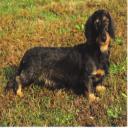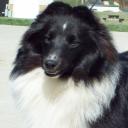Yahoo Answers is shutting down on May 4th, 2021 (Eastern Time) and the Yahoo Answers website is now in read-only mode. There will be no changes to other Yahoo properties or services, or your Yahoo account. You can find more information about the Yahoo Answers shutdown and how to download your data on this help page.
Trending News
What does it take for a mix to be considered a pure breed (if anything?)?
Out of all the AKC accepted breeds we have circulating today, most were at one point produced by crossing other existing breeds way back when, right? Now we are burdened with "designer" mutts being bred left and right. If some of these seemingly passionate breeders continue to breed generation upon generation of same-mix mutts (for instance 'labradoodles' bred to 'labradoodles'), will these lines eventually stand a chance at being considered as their own breed? Or will that just never happen?
Relax you silly people. Never once did I say I supported the breeding of mutts or did it myself, did I? This is just a harmless question. Answer it nicely, or get out.
I know hundreds of years ago, there were "types" of dogs rather than the more formulated breeds we have today. However, I've occasionally seen some sources describing a breed as originally being crossed between two or more breeds that still exist today. For instance on English Foxhounds, "They were developed by crossing a variety of hounds with the Bulldog, Greyhound and the Fox Terrier." http://www.dogbreedinfo.com/englishfoxhound.htm
I wasn't talking about the "labradoodles" as they are today. Obviously the development of a breed takes.. oh, quite a while longer than the fad has been going on thus far. But in theory, SHOULD labradoodle breeders keep this up for another hundred or so years.
Very good points on the strictness that went into it back then (lots of purposeful culling that definitely doesn't happen any more). As well as the work-use of the breed (which isn't nearly as much in demand these days as "non-shedding" is)
11 Answers
- 4Her4LifeLv 78 years agoFavorite Answer
They could be considered their own breed someday, as you pointed out, the majority of today's breeds utilized more than one breed in their early development. Based on the dictionary definition of a "breed" as sharing the same traits, having a presumed common ancestry, and producing "like" when bred together, my qualification for a group of dogs to be a"breed" is as follows:
(1) Must have a definition of phenotype (visible traits) shared by all members of the breed. More than one color can be allowed, so can more than one coat type, etc, but it needs to be specified. The "designer" dogs are NOT being defined by traits, but only be which breeds are in the mix. If you got all "Labradoodles" to actually be as low-shedding as a Poodle with the temperament of a Lab, we could talk.
(2) Phenotype must be set through line breeding. If you cross a so-called "f1" mongrel with another, technically you could end up with pups that were 100% genetically either parent breed. If I crossed a Labrador with a Golden, 100% of that first generation would have short hair because that trait predominates, but it would take generations of breeding to eliminate the long-haired gene from the breeding pool - in the Belgian Shepherd breeds (considered separate breeds by the AKC) even 50 years after the last cross-variety breeding you can still have Tervuren pups turn up in Malinois and Groenendahl litters and Malinois show up in Laekenois litters. Line breeding fairly close relatives will give you litters where pups have two copies of the same gene at each locus, or where any hidden recessive traits can be identified and proper care taken in the pedigree to remove those genes.
(3) Must have common ancestry, at least all "lines" should have at some point been crossed with all other "lines" to ensure that the type remains set. For example, Labradors are generally homogenous at the K locus which makes them a solid color instead of brindle, sable, agouti, or and-tan. If bred to a black German Shepherd Dog, however, who has the recessive A gene responsible for his phenotypically identical solid black color, that homogeneity would be lost. In the second generation from ALL black dogs (for as many generations on either side as you wanted) you could get wolf sable, clear sable, and-tan, color patterns. Requiring a "presumed common ancestry" helps to eliminate most of these same-phenotype/different-genotype adventures.
There are breeds developed in the last 60 years that are AKC recognized or on their way - look at the Black Russian Terrier, American Hairless Terrier, and Miniature American Shepherd, for a few, and there are breeds under development that will probably get there in our lifetimes - the White Swiss Shepherd and Tamaskan to name two. But at some point you have to close the stud book and spend a few decades and dozen generations setting that phenotype and genotype to actually make it a breed. The "designer" dogs are failing at this because their definition was never type (pheno or geno) but only shared mongrel ancestry, until they have a paradigm shift to actually creating new true-breeding breeds, there will just more expensive mongrels.
- •Poppy•Lv 78 years ago
Theoretically, yes. However, almost NONE of these "breeders" are breeding for any one trait or have any real knowledge of genetics - period. They put two dogs together, put out a line that they are "sweet" or "non shedding" and just rake in the cash.
For a breed to be a breed it must breed true. It's a very simple concept, but is hard to achieve. For example, take a Lab. You can very easily recognize one; they have a very specific body shape, ear set, head shape, color, etc. Even the temperament (should be) predictable. Naturally there are issues with overbreeding where you get dogs that don't fit the standard, but for the most part you can still recognize a Lab as a Lab and as such there is a very clear standard as to what a Lab should be.
To *get* that breed to begin with, though, a lot of work was put in. For one thing, a purpose (retrieving) was desired before the breed was created. Breeders decided what worked for their purposes, and what didn't. So, for example, the desire to retrieve and to be friendly toward people was a very important trait, so it was bred for. A double coat to keep them warm in the water was another trait that was bred for. To do this, a very clear knowledge of the dogs they were starting off with was needed. They had to seek out very specific dogs that had the traits they wanted; they had to know about dominant and recessive traits and how they would most likely manifest themselves. And slowly but surely a breed that we can recognize today was created.
Again, it may be possible. But as these dogs have no real purpose, they have no real basis. The "breeders" have no real idea of what they are doing, and have no need to as suckers are willing to buy from them anyway. So it's not gonna happen.
- WyrDachsieLv 78 years ago
Labradoodles and cockapoos, have been being bred now, for over 20 years and they still don't breed true.
It will never happen. The people who helped create purebred dogs, have a mission,a goal, they knew what they wanted, type of personality, type of coat, height, weight, what their purpose was to be. They culled pups that did not meet what they were looking for. They wrote down everything.
Todays greeders are not interested in that, they are simply interested in money and there lies the difference.
- PamelaLv 78 years ago
It takes many, many years of consistent breeding for any mix to qualify for admission to the AKC.
Labrador/Poodle, and Golden Retriever/Poodle mixes will most likely never gain admission.
Because there is to many inconsistencies in the dogs.
Some(few) shed, most shed heavily. Are not allergy free as breeders claim.
Back in the 1930s or 1940s some bodies cocker spaniel mated with a poodle, well over all those years breeders have been trying to get them recognized with AKC and it is yet to happen.
And chances are they won't be. Because of the inconsistencies in them.
Source(s): Voting member of the American Kennel Club for 27 years. - ?Lv 68 years ago
I know the bull mastiff was a mixed breed at one time. http://www.dogbreedinfo.com/bullmastiff.htm The English kennel club recognized it as a breed, soon after the AKC recognized it also. I have no idea if this answers your question or not
- MarianneLv 78 years ago
Breeders of mixes have to follow the pattern that other mixed breeders did. You need to form a Breed group, establish a standard and then apply for acceptance into an established kennel club for registration, such as either the American Kennel Club, the United Kennel Club, or your countries Kennel Club. It takes a long time and dedicated breeders to establish a new purebred.
- Anonymous8 years ago
I doubt labradoodle will ever be considered a breed. As for the original question, IMO the breed becomes purebred after many generations of carefully breeding. That's my spin on it
ADD: Wow, 6 TD's because I answered the question with the best of my abilities
- 8 years ago
honestly, sometimes it's better that they don't become breeds. because then, those dogs are brought even more to the attention of puppy mills and backyard breeders. some lines might become recognized by the akc, but sometimes dogs are better left bred by a few passionate breeders who love their mixed breed.
Source(s): me - Anonymous8 years ago
WRONG!!!!!!!!!!!!! No they weren't! There weren't any breeds to begin with.
Only TYPES...selectively bred & culled by those that actually knew WTF they were doing & why! Done for hundreds of years...NOT 9wks in some morons backyard,made just to be dumped on lazy gullible cheapazz suckers.
Ah...you imagine "dogbreedinfo" is FACT!!!!!!!!!!!!!!!!!!!! Now I understand...you read BS & it lap up ...figures.





